2019 NISSAN TITAN check engine light
[x] Cancel search: check engine lightPage 593 of 682
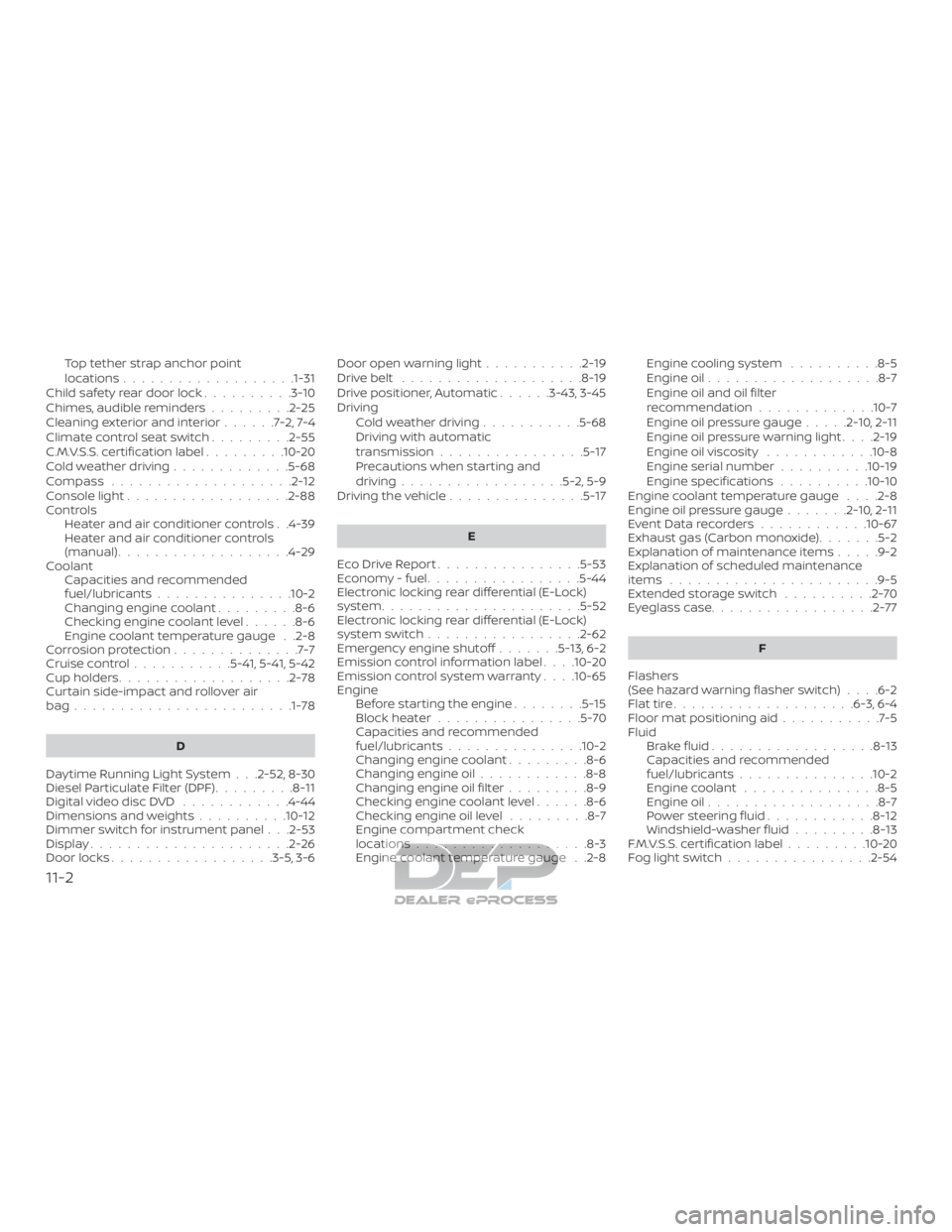
Top tether strap anchor point
locations...................1-31
Child safety rear door lock ..........3-10
Chimes, audible reminders .........2-25
Cleaningexteriorandinterior......7-2,7-4
Climatecontrolseatswitch.........2-55
C.M.V.S.S. certification label .........10-20
Coldweatherdriving.............5-68
Compass ....................2-12
Console light ..................2-88
Controls Heater and air conditioner controls . .4-39
Heater and air conditioner controls
(manual) ...................4-29
Coolant Capacities and recommended
fuel/lubricants...............10-2
Changing engine coolant .........8-6
Checking engine coolant level ......8-6
Engine coolant temperature gauge . .2-8
Corrosionprotection..............7-7
Cruisecontrol...........5-41,5-41,5-42
Cupholders...................2-78
Curtain side-impact and rollover air
bag........................1-78
D
Daytime Running Light System . . .2-52, 8-30
Diesel Particulate Filter (DPF) .........8-11
DigitalvideodiscDVD ............4-44
Dimensions and weights ..........10-12
Dimmer switch for instrument panel . . .2-53
Display......................2-26
Door locks ..................3-5,3-6 Door open warning light
...........2-19
Drivebelt ....................8-19
Drive positioner, Automatic ......3-43,3-45
Driving Cold weather driving ...........5-68
Driving with automatic
transmission ................5-17
Precautions when starting and
driving..................5-2,5-9
Drivingthevehicle...............5-17
E
Eco Drive Report ................5-53
Economy - fuel .................5-44
Electronic locking rear differential (E-Lock)
system ......................5-52
Electronic locking rear differential (E-Lock)
system switch .................2-62
Emergency engine shutoff .......5-13,6-2
Emission control information label . . . .10-20
Emission control system warranty . . . .10-65
Engine Before starting the engine ........5-15
Blockheater................5-70
Capacities and recommended
fuel/lubricants...............10-2
Changing engine coolant .........8-6
Changing engine oil ............8-8
Changing engine oil filter .........8-9
Checking engine coolant level ......8-6
Checking engine oil level .........8-7
Engine compartment check
locations...................8-3
Engine coolant temperature gauge . .2-8 Engine cooling system
..........8-5
Engine oil ...................8-7
Engine oil and oil filter
recommendation .............10-7
Engine oil pressure gauge .....2-10,2-11
Engine oil pressure warning light ....2-19
Engine oil viscosity ............10-8
Engine serial numbe r..........10-19
Engine specifications ..........10-10
Engine coolant temperature gauge ....2-8
Engine oil pressure gauge .......2-10,2-11
EventDatarecorders............10-67
Exhaust gas (Carbon monoxide) .......5-2
Explanation of maintenance items .....9-2
Explanation of scheduled maintenance
items .......................9-5
Extended storage switch ..........2-70
Eyeglasscase..................2-77
F
Flashers
(Seehazardwarningflasherswitch)....6-2
Flattire....................6-3,6-4
F lo
ormatpositioningaid...........7-5
Fluid Brakefluid..................8-13
Capacities and recommended
fuel/lubricants...............10-2
Engine coolant ...............8-5
Engine oil ...................8-7
Powersteeringfluid............8-12
Windshield-washer fluid .........8-13
F.M.V.S.S. certification label .........10-20
Foglightswitch................2-54
11-2
Page 595 of 682

Key fob battery replacement........8-27
Keyless entry With Intelligent Key system
(See Intelligent Key system) .......3-16
Keys NISSAN Intelligent Key® .......3-2,3-10
NISSAN Vehicle Immobilizer System
keys......................3-4
L
Labels Air conditioner specification label . . .10-21
C.M.V.S.S. certification label .......10-20
Emission control information label . .10-20
Engine serial numbe r..........10-19
F.M.V.S.S. certification label .......10-20
Tire and Loading Information label . .10-21
Vehicle identification number (VIN) . .10-18
Vehicle identification number (VIN)
plate.....................10-18
Warning labels (for SRS) .........1-80
LATCH (Lower Anchors and Tethers for
CHildren)System............... .1-29
License plate Installing the license plate .......10-22
Light Airbagwarninglight........1-81, 2-22
Brakelight(Seestoplight)........8-32
Bulb check/instrument panel ......2-17
Bulb replacement .............8-32
Charge warning light ...........2-19
Console light ................2-88
ExteriorandInteriorlights........8-32 Foglights..................8-29
Foglightswitch..............2-54
Headlight and turn signal switch
....2-49
Headlightcontrolswitch.........2-49
Headlights .................8-29
Interiorlight.................2-87
Lightbulbs.................8-29
Low tire pressure warning light .....2-20
Low windshield-washer fluid warning
light......................2-38
Passenger air bag and status light . . .1-63
Personal lights ...............2-89
Security indicator light ..........2-25
Warning/indicator lights and audible
reminders ...............2-17,2-23
Lights......................8-29 Maplights..................2-88
Lock Child safety rear door lock ........3-10
Door locks ................3-5,3-6
Power door locks ..............3-7
Loose fuel cap warning ...........2-40
Lowfuelwarninglight.........2-22,2-37
Low tire pressure warning light .......2-20
Low windshield-washer fluid warning
light........................2-38
Luggage hook .................2-82
Luggage
(See vehicle loading information) .....10-23
M
Maintenance General maintenance ...........9-2 Insidethevehicle..............9-3
Maintenance precautions
.........8-2
Outsidethevehicle.............9-2
Seat belt maintenance ..........1-23
Under the hood and vehicle .......9-4
Maintenance log ................9-18
Maintenance requirements ..........9-2
Maintenance schedules ............9-7
Malfunctionindicatorlight......2-22,2-24
Manual front seat adjustment ........1-4
Maplights....................2-88
Map pocket ...................2-72
Memory Seat ..............3-43,3-45
Meters and gauges ...........2-6,2-10
Instrument brightness control .....2-53
Mirror Automatic anti-glare inside mirror. . .3-34
Outsidemirrors..............3-35
Rearview...................3-33
Vanitymirror................3-33
Mirrors......................3-33
Moving Object Detection (MOD) ......4-24
N
NissanConnect® Owner's Manual ......
4-
2
NISSAN Intelligent Key® .........3-2,3-10
NISSAN Vehicle Immobilizer
System..................2-44,5-14
O
Octane rating (See fuel octane rating) . . .10-7
Odometer ....................2-7
11-4
Page 596 of 682

OilCapacities and recommended
fuel/lubricants...............10-2
Changing engine oil ............8-8
Changing engine oil filter .........8-9
Checking engine oil level .........8-7
Engine oil ...................8-7
Engine oil and oil filter
recommendation .............10-7
Engine oil viscosity ............10-8
Outsidemirrors................3-35
Overhead sunglasses holder ........2-77
Overheat Ifyourvehicleoverheats.........6-16
Owner's manual order form ........10-68
Owner's manual/service manual order
information..................10-68
P
Parking Parking brake operation .........5-23
Parking/parkingonhills.........5-55
Parkingbrake..................5-23
Personal lights .................2-89
Power Front seat adjustment ...........1-5
Power door locks ..............3-7
Poweroutlet..........2-67,2-67,2-69
Powerrearwindows...........2-84
Powersteeringfluid............8-12
Power steering system ..........5-55
Powerwindows..............2-83
Rearpowerwindows...........2-84
Powerinverterswitch ............2-63 Poweroutlet............2-67,2-67,2-69
Powersteering.................5-55
Powersteeringfluid..............8-12
Precautions
Maintenance precautions .........8-2
On-pavement and off-road driving
precautions .................5-7
Precautions on booster
seats ........1-26, 1-34, 1-40, 1-44, 1-49
Precautions on child restraints . .1-26, 1-34,
1-40, 1-44, 1-49
Precautions on seat belt usage .....1-15
Precautions on supplemental restraint
system .................1-53, 1-68
Precautions when starting and
driving..................5-2,5-9
Push starting ..................6-16
R
Radio Car phone or CB radio ..........4-89
Rain sensor ...................2-47
Readiness for inspection maintenance
(I/M) test ....................10-67
RearCrossTrafficAlert(RCTA)........5-33
Rear Door Alert .............2-41,2-66
Rearpowerwindows.............2-84
Rearseat.....................1-4
Rear Seat Infotainment (RSI) System . . .4-44
Rearslidingwindow .............2-86
Rear sonar system OFF switch .......2-64
Rearviewmirror................3-33
RearViewMonitor................4-3 Rear window and/or outside mirror
defrosterswitch................2-48
Recommended Fluids
............10-2
Recorders EventData.................10-67
Refrigerant recommendation ........10-8
Registering a vehicle in another
country .....................10-18
Remote Engine Start ..........3-24,5-16
Reporting safety defects (US only) . . . .10-66
S
Safety Child safety rear door lock ........3-10
Child seat belts . .1-26, 1-34, 1-40, 1-44, 1-49
Reporting safety defects (US only) . .10-66
Seat adjustment Front manual seat adjustment ......1-4
Front power seat adjustment ......1-5
Seatback pockets ...............2-72
Seat belt Childsafety.................1-24
Infants and small children ........1-25
InjuredPerson .............. .1-18
L a r
gerchildren.............. .1-25
Precautionsonseatbeltusage.....1-15
Pregnant women .............1-18
Seat belt extenders ............1-23
Seat belt maintenance ..........1-23
Seatbelts................1-15, 7-6
Shoulder belt height adjustment . . . .1-22
Three-pointtypewithretractor.....1-18
Seat belt extenders ..............1-23
Seatbeltwarninglight.........1-18, 2-19
11-5
Page 611 of 682
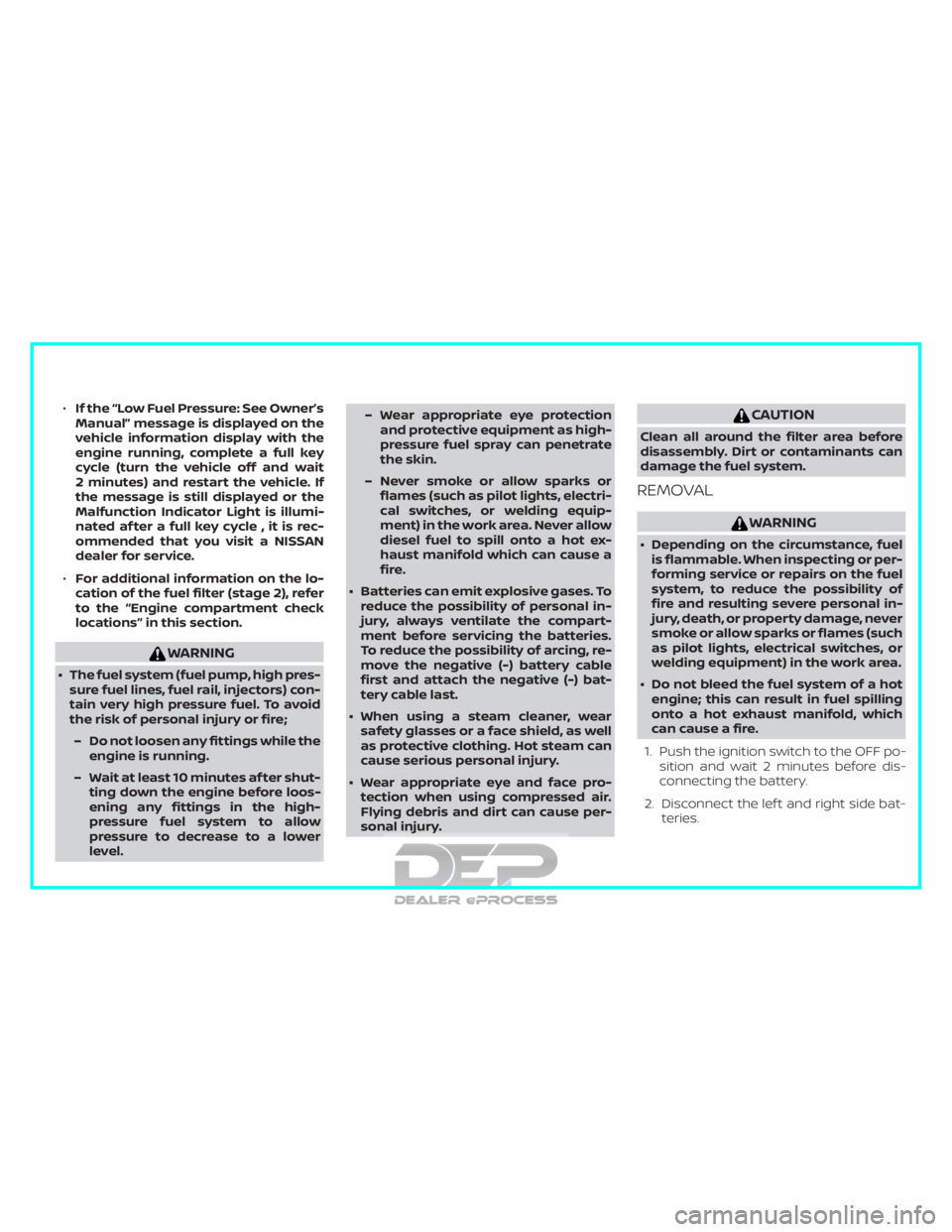
∙If the “Low Fuel Pressure: See Owner’s
Manual” message is displayed on the
vehicle information display with the
engine running, complete a full key
cycle (turn the vehicle off and wait
2 minutes) and restart the vehicle. If
the message is still displayed or the
Malfunction Indicator Light is illumi-
nated af ter a full key cycle , it is rec-
ommended that you visit a NISSAN
dealer for service.
∙ For additional information on the lo-
cation of the fuel filter (stage 2), refer
to the “Engine compartment check
locations” in this section.
WARNING
∙ The fuel system (fuel pump, high pres- sure fuel lines, fuel rail, injectors) con-
tain very high pressure fuel. To avoid
the risk of personal injury or fire;
– Do not loosen any fittings while the engine is running.
– Wait at least 10 minutes af ter shut- ting down the engine before loos-
ening any fittings in the high-
pressure fuel system to allow
pressure to decrease to a lower
level. – Wear appropriate eye protection
and protective equipment as high-
pressure fuel spray can penetrate
the skin.
– Never smoke or allow sparks or flames (such as pilot lights, electri-
cal switches, or welding equip-
ment) in the work area. Never allow
diesel fuel to spill onto a hot ex-
haust manifold which can cause a
fire.
∙ Batteries can emit explosive gases. To reduce the possibility of personal in-
jury, always ventilate the compart-
ment before servicing the batteries.
To reduce the possibility of arcing, re-
move the negative (-) battery cable
first and attach the negative (-) bat-
tery cable last.
∙ When using a steam cleaner, wear safety glasses or a face shield, as well
as protective clothing. Hot steam can
cause serious personal injury.
∙ Wear appropriate eye and face pro- tection when using compressed air.
Flying debris and dirt can cause per-
sonal injury.
CAUTION
Clean all around the filter area before
disassembly. Dirt or contaminants can
damage the fuel system.
REMOVAL
WARNING
∙ Depending on the circumstance, fuelis flammable. When inspecting or per-
forming service or repairs on the fuel
system, to reduce the possibility of
fire and resulting severe personal in-
jury, death, or property damage, never
smoke or allow sparks or flames (such
as pilot lights, electrical switches, or
welding equipment) in the work area.
∙ Do not bleed the fuel system of a hot engine; this can result in fuel spilling
onto a hot exhaust manifold, which
can cause a fire.
1. Push the ignition switch to the OFF po- sition and wait 2 minutes before dis-
connecting the battery.
2. Disconnect the lef t and right side bat- teries.
Page 623 of 682
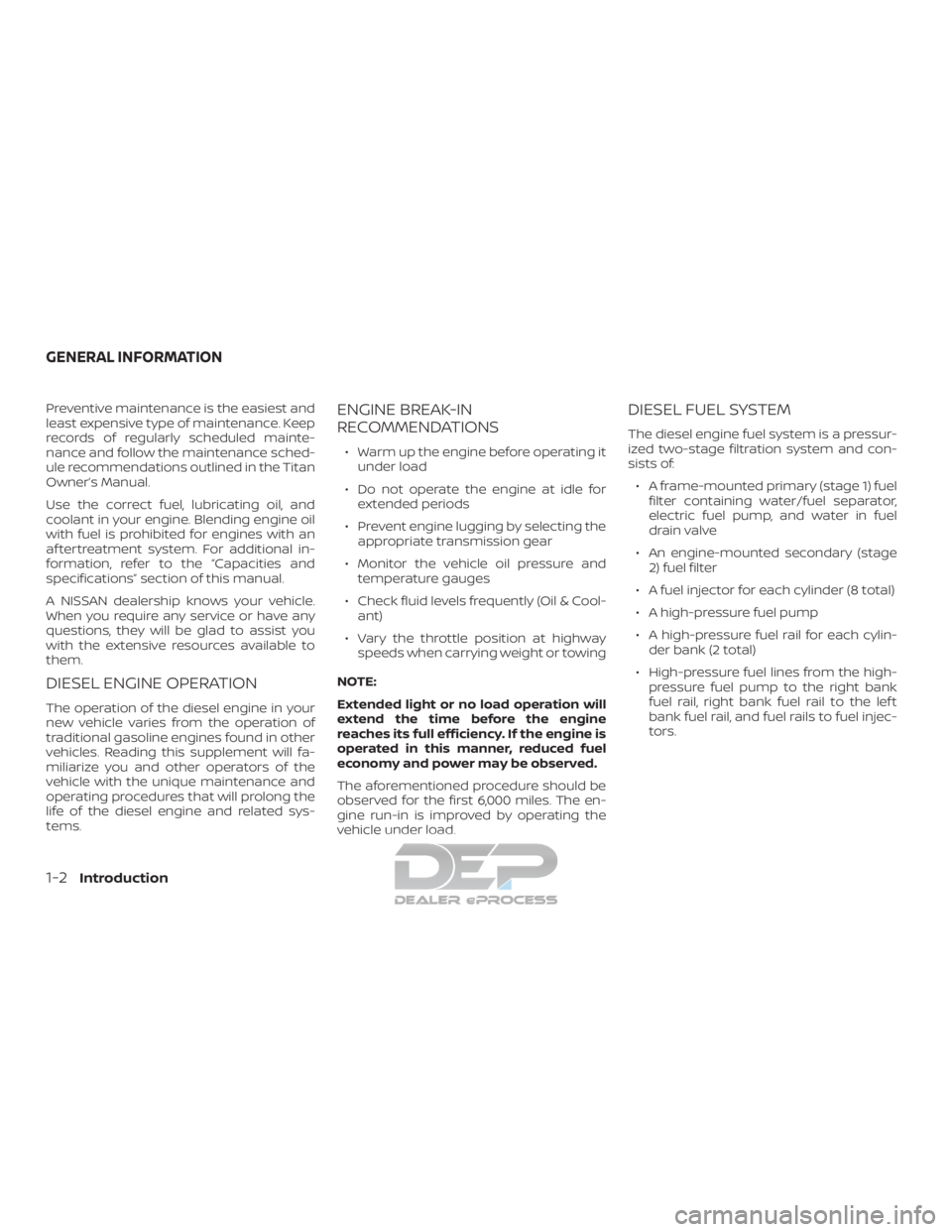
Preventive maintenance is the easiest and
least expensive type of maintenance. Keep
records of regularly scheduled mainte-
nance and follow the maintenance sched-
ule recommendations outlined in the Titan
Owner’s Manual.
Use the correct fuel, lubricating oil, and
coolant in your engine. Blending engine oil
with fuel is prohibited for engines with an
af tertreatment system. For additional in-
formation, refer to the “Capacities and
specifications” section of this manual.
A NISSAN dealership knows your vehicle.
When you require any service or have any
questions, they will be glad to assist you
with the extensive resources available to
them.
DIESEL ENGINE OPERATION
The operation of the diesel engine in your
new vehicle varies from the operation of
traditional gasoline engines found in other
vehicles. Reading this supplement will fa-
miliarize you and other operators of the
vehicle with the unique maintenance and
operating procedures that will prolong the
life of the diesel engine and related sys-
tems.
ENGINE BREAK-IN
RECOMMENDATIONS
∙ Warm up the engine before operating itunder load
∙ Do not operate the engine at idle for extended periods
∙ Prevent engine lugging by selecting the appropriate transmission gear
∙ Monitor the vehicle oil pressure and temperature gauges
∙ Check fluid levels frequently (Oil & Cool- ant)
∙ Vary the throttle position at highway speeds when carrying weight or towing
NOTE:
Extended light or no load operation will
extend the time before the engine
reaches its full efficiency. If the engine is
operated in this manner, reduced fuel
economy and power may be observed.
The aforementioned procedure should be
observed for the first 6,000 miles. The en-
gine run-in is improved by operating the
vehicle under load.
DIESEL FUEL SYSTEM
The diesel engine fuel system is a pressur-
ized two-stage filtration system and con-
sists of: ∙ A frame-mounted primary (stage 1) fuel filter containing water/fuel separator,
electric fuel pump, and water in fuel
drain valve
∙ An engine-mounted secondary (stage 2) fuel filter
∙ A fuel injector for each cylinder (8 total)
∙ A high-pressure fuel pump
∙ A high-pressure fuel rail for each cylin- der bank (2 total)
∙ High-pressure fuel lines from the high- pressure fuel pump to the right bank
fuel rail, right bank fuel rail to the lef t
bank fuel rail, and fuel rails to fuel injec-
tors.
GENERAL INFORMATION
1-2Introduction
Page 624 of 682
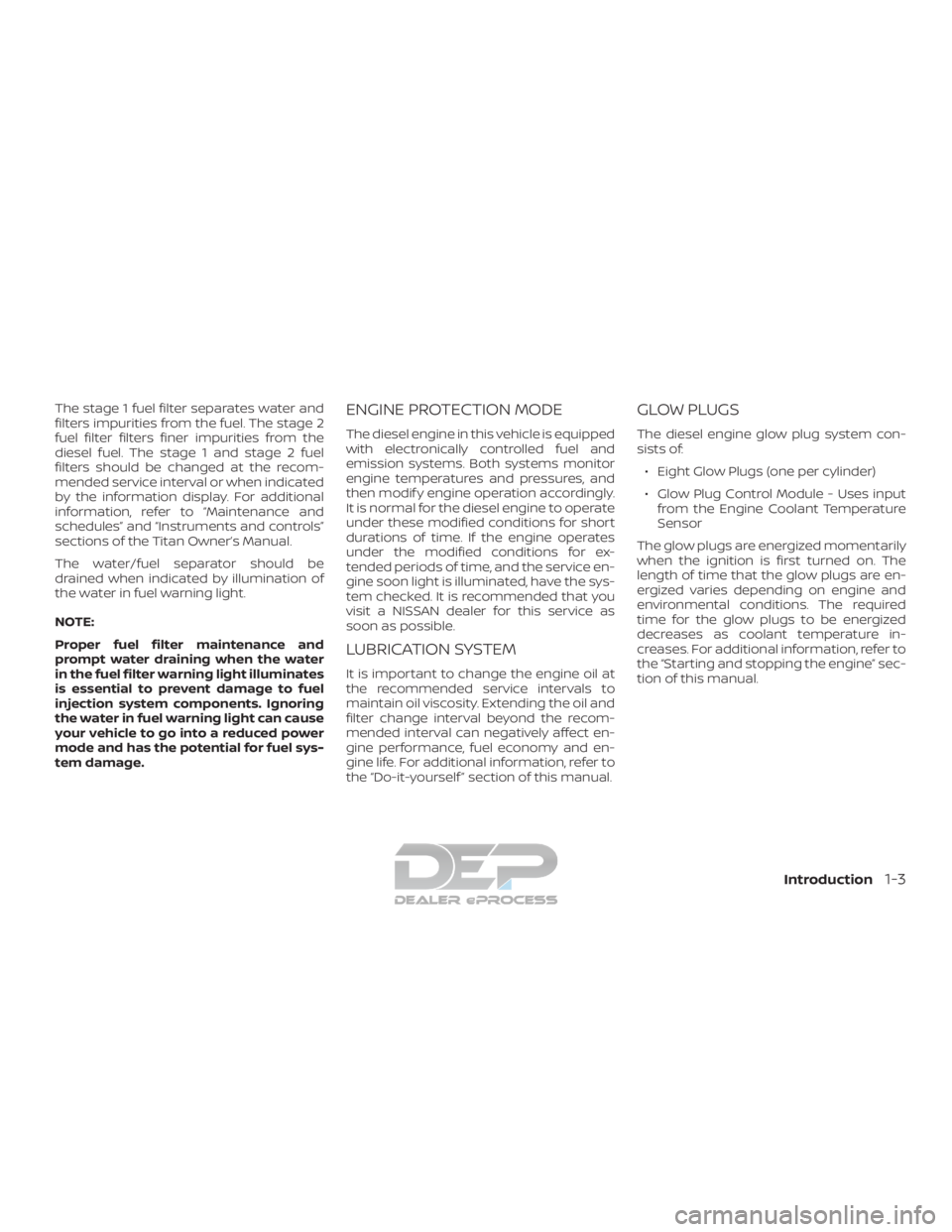
The stage 1 fuel filter separates water and
filters impurities from the fuel. The stage 2
fuel filter filters finer impurities from the
diesel fuel. The stage 1 and stage 2 fuel
filters should be changed at the recom-
mended service interval or when indicated
by the information display. For additional
information, refer to “Maintenance and
schedules” and “Instruments and controls”
sections of the Titan Owner’s Manual.
The water/fuel separator should be
drained when indicated by illumination of
the water in fuel warning light.
NOTE:
Proper fuel filter maintenance and
prompt water draining when the water
in the fuel filter warning light illuminates
is essential to prevent damage to fuel
injection system components. Ignoring
the water in fuel warning light can cause
your vehicle to go into a reduced power
mode and has the potential for fuel sys-
tem damage.ENGINE PROTECTION MODE
The diesel engine in this vehicle is equipped
with electronically controlled fuel and
emission systems. Both systems monitor
engine temperatures and pressures, and
then modif y engine operation accordingly.
It is normal for the diesel engine to operate
under these modified conditions for short
durations of time. If the engine operates
under the modified conditions for ex-
tended periods of time, and the service en-
gine soon light is illuminated, have the sys-
tem checked. It is recommended that you
visit a NISSAN dealer for this service as
soon as possible.
LUBRICATION SYSTEM
It is important to change the engine oil at
the recommended service intervals to
maintain oil viscosity. Extending the oil and
filter change interval beyond the recom-
mended interval can negatively affect en-
gine performance, fuel economy and en-
gine life. For additional information, refer to
the “Do-it-yourself ” section of this manual.
GLOW PLUGS
The diesel engine glow plug system con-
sists of:∙ Eight Glow Plugs (one per cylinder)
∙ Glow Plug Control Module - Uses input from the Engine Coolant Temperature
Sensor
The glow plugs are energized momentarily
when the ignition is first turned on. The
length of time that the glow plugs are en-
ergized varies depending on engine and
environmental conditions. The required
time for the glow plugs to be energized
decreases as coolant temperature in-
creases. For additional information, refer to
the “Starting and stopping the engine” sec-
tion of this manual.
Introduction1-3
Page 633 of 682
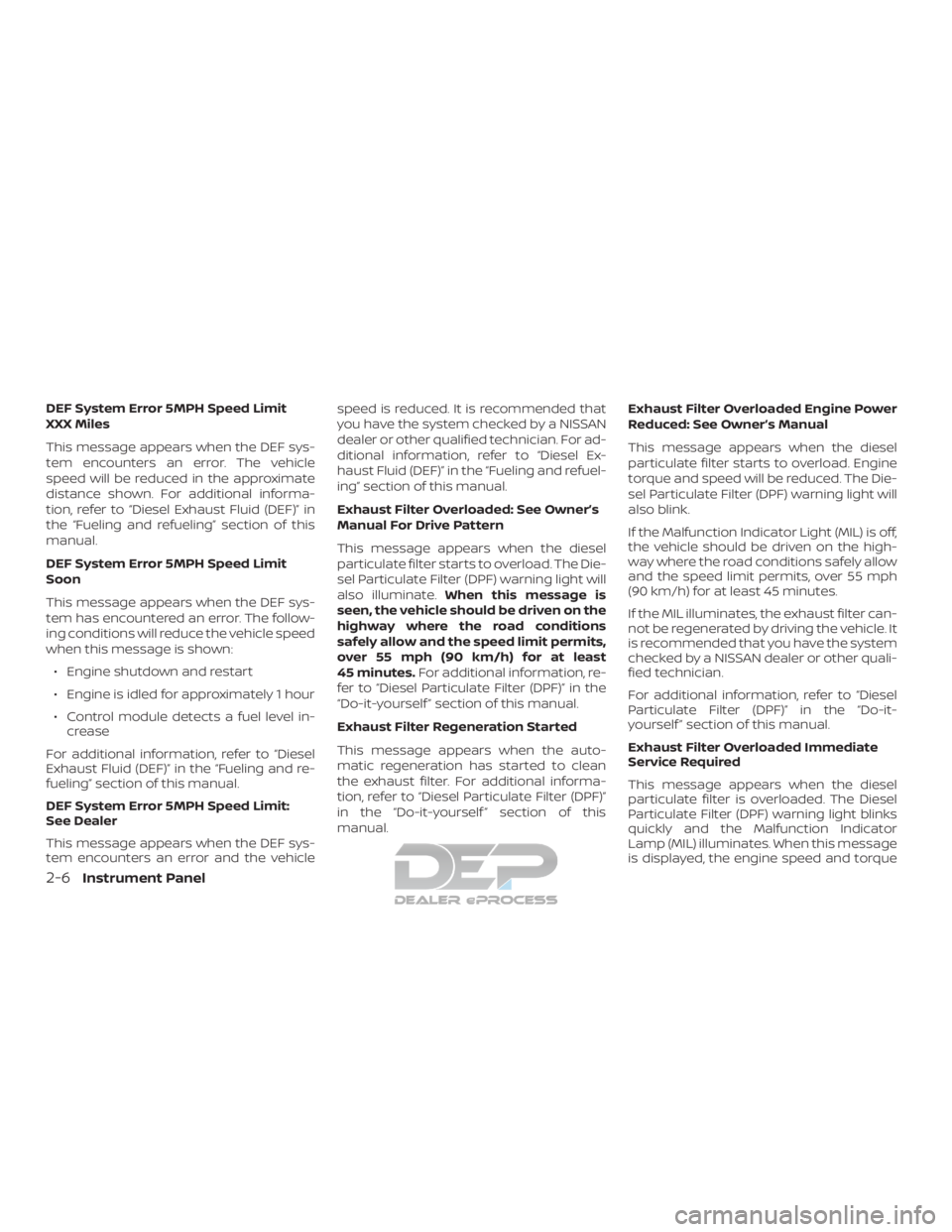
DEF System Error 5MPH Speed Limit
XXX Miles
This message appears when the DEF sys-
tem encounters an error. The vehicle
speed will be reduced in the approximate
distance shown. For additional informa-
tion, refer to “Diesel Exhaust Fluid (DEF)” in
the “Fueling and refueling” section of this
manual.
DEF System Error 5MPH Speed Limit
Soon
This message appears when the DEF sys-
tem has encountered an error. The follow-
ing conditions will reduce the vehicle speed
when this message is shown:∙ Engine shutdown and restart
∙ Engine is idled for approximately 1 hour
∙ Control module detects a fuel level in- crease
For additional information, refer to “Diesel
Exhaust Fluid (DEF)” in the “Fueling and re-
fueling” section of this manual.
DEF System Error 5MPH Speed Limit:
See Dealer
This message appears when the DEF sys-
tem encounters an error and the vehicle speed is reduced. It is recommended that
you have the system checked by a NISSAN
dealer or other qualified technician. For ad-
ditional information, refer to “Diesel Ex-
haust Fluid (DEF)” in the “Fueling and refuel-
ing” section of this manual.
Exhaust Filter Overloaded: See Owner’s
Manual For Drive Pattern
This message appears when the diesel
particulate filter starts to overload. The Die-
sel Particulate Filter (DPF) warning light will
also illuminate.
When this message is
seen, the vehicle should be driven on the
highway where the road conditions
safely allow and the speed limit permits,
over 55 mph (90 km/h) for at least
45 minutes. For additional information, re-
fer to “Diesel Particulate Filter (DPF)” in the
“Do-it-yourself ” section of this manual.
Exhaust Filter Regeneration Started
This message appears when the auto-
matic regeneration has started to clean
the exhaust filter. For additional informa-
tion, refer to “Diesel Particulate Filter (DPF)”
in the “Do-it-yourself ” section of this
manual. Exhaust Filter Overloaded Engine Power
Reduced: See Owner’s Manual
This message appears when the diesel
particulate filter starts to overload. Engine
torque and speed will be reduced. The Die-
sel Particulate Filter (DPF) warning light will
also blink.
If the Malfunction Indicator Light (MIL) is off,
the vehicle should be driven on the high-
way where the road conditions safely allow
and the speed limit permits, over 55 mph
(90 km/h) for at least 45 minutes.
If the MIL illuminates, the exhaust filter can-
not be regenerated by driving the vehicle. It
is recommended that you have the system
checked by a NISSAN dealer or other quali-
fied technician.
For additional information, refer to “Diesel
Particulate Filter (DPF)” in the “Do-it-
yourself ” section of this manual.
Exhaust Filter Overloaded Immediate
Service Required
This message appears when the diesel
particulate filter is overloaded. The Diesel
Particulate Filter (DPF) warning light blinks
quickly and the Malfunction Indicator
Lamp (MIL) illuminates. When this message
is displayed, the engine speed and torque
2-6Instrument Panel
Page 634 of 682
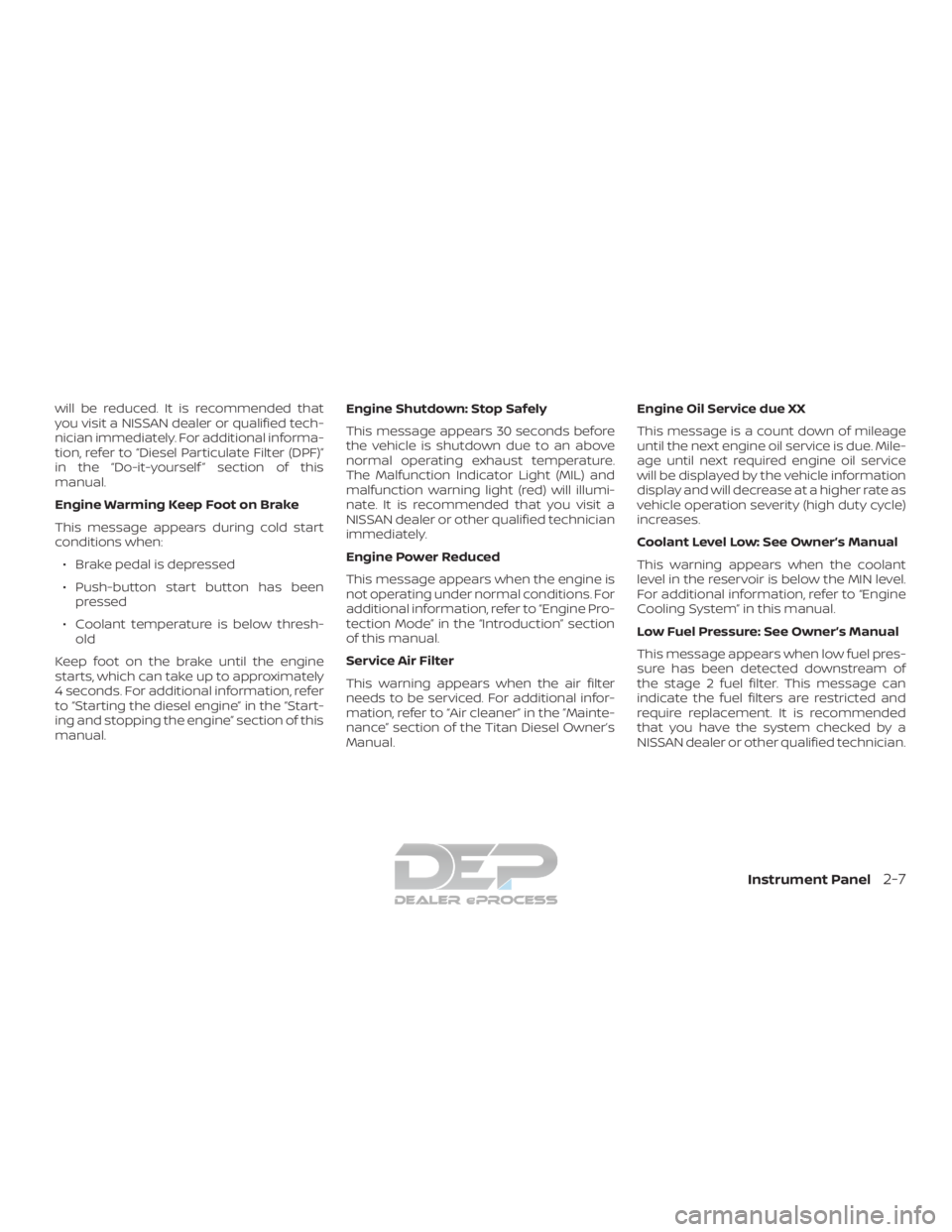
will be reduced. It is recommended that
you visit a NISSAN dealer or qualified tech-
nician immediately. For additional informa-
tion, refer to “Diesel Particulate Filter (DPF)”
in the “Do-it-yourself ” section of this
manual.
Engine Warming Keep Foot on Brake
This message appears during cold start
conditions when:∙ Brake pedal is depressed
∙ Push-button start button has been pressed
∙ Coolant temperature is below thresh- old
Keep foot on the brake until the engine
starts, which can take up to approximately
4 seconds. For additional information, refer
to “Starting the diesel engine” in the “Start-
ing and stopping the engine” section of this
manual. Engine Shutdown: Stop Safely
This message appears 30 seconds before
the vehicle is shutdown due to an above
normal operating exhaust temperature.
The Malfunction Indicator Light (MIL) and
malfunction warning light (red) will illumi-
nate. It is recommended that you visit a
NISSAN dealer or other qualified technician
immediately.
Engine Power Reduced
This message appears when the engine is
not operating under normal conditions. For
additional information, refer to “Engine Pro-
tection Mode” in the “Introduction” section
of this manual.
Service Air Filter
This warning appears when the air filter
needs to be serviced. For additional infor-
mation, refer to “Air cleaner” in the ”Mainte-
nance” section of the Titan Diesel Owner’s
Manual.Engine Oil Service due XX
This message is a count down of mileage
until the next engine oil service is due. Mile-
age until next required engine oil service
will be displayed by the vehicle information
display and will decrease at a higher rate as
vehicle operation severity (high duty cycle)
increases.
Coolant Level Low: See Owner’s Manual
This warning appears when the coolant
level in the reservoir is below the MIN level.
For additional information, refer to “Engine
Cooling System” in this manual.
Low Fuel Pressure: See Owner’s Manual
This message appears when low fuel pres-
sure has been detected downstream of
the stage 2 fuel filter. This message can
indicate the fuel filters are restricted and
require replacement. It is recommended
that you have the system checked by a
NISSAN dealer or other qualified technician.
Instrument Panel2-7